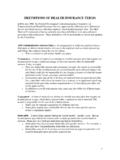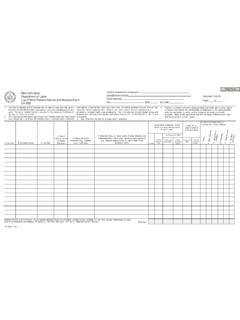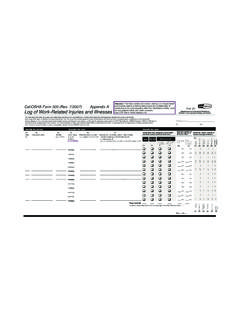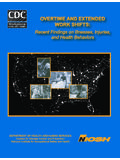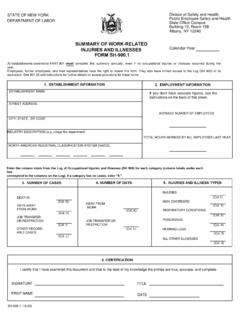Transcription of NONFATAL OCCUPATIONAL INJURIES AND …
1 For release 10:00 (EST) Thursday, November 10, 2016 USDL-16-2130. Technical information: (202) 691-6170 Media contact: (202) 691-5902 NONFATAL OCCUPATIONAL INJURIES AND illnesses REQUIRING DAYS AWAY FROM work , 2015. The overall incidence rate of NONFATAL OCCUPATIONAL injury and illness cases requiring days away from work to recuperate was cases per 10,000 full-time workers in 2015, down from cases in 2014, the Bureau of Labor Statistics reported today. In 2015, there were 1,153,490 days-away-from- work cases in private industry, state government, and local government essentially unchanged from the number of cases reported in 2014. The median days away from work to recuperate a key measure of severity of INJURIES and illnesses was 8 days in 2015, 1 day fewer than reported in 2014. (See table 1.). Private sector occupations In the private sector, the incidence rate per 10,000 full-time workers was cases in 2015, down from cases in 2014. (See table 1.). Occupations that had among the highest number of cases in 2015 resulting in days away from work included heavy and tractor-trailer truck drivers; laborers and freight, stock, and material movers; and nursing assistants.
2 (See table 3.). The incidence rates decreased for heavy and tractor-trailer truck drivers ( cases per 10,000 full- time workers in 2015, down from ) and nursing assistants ( in 2015, down from ). Private sector laborers and freight, stock, and material movers had 56,550 days-away-from- work cases in 2015, an increase from 2014 levels. However, the incidence rate of cases was not significantly different from the rate reported in 2014 ( cases). (See table 3 and chart A). Chart A. Incidence rates for OCCUPATIONAL INJURIES and illnesses with days away from work by selected occupations, 2011 15 700. 600. Incidence 500. rate 400. per 10,000 300. full time workers 200. 100. 0. Heavy and tractor Laborers and Nursing assistants Correctional Police and sheriff's Firefighters (local Janitors and trailer truck drivers freight, stock, and (private industry) officers and jailers patrol officers gov.) cleaners (local (private industry) material movers (state gov.) (local gov.) gov.)
3 (private industry). 2011 2012 2013 2014 2015. Note: These occupations had at least percent of employment and among the highest case counts in their respective ownership classes. Source: Bureau of Labor Statistics State and local government occupations The incidence rates for NONFATAL OCCUPATIONAL INJURIES and illnesses with days away from work for state ( cases per 10,000 full-time workers) and local government ( ) were essentially unchanged in 2015. (See table 1.). In state or local government, there were five occupations with at least 10,000 cases: police and sheriff's patrol officers; firefighters; janitors and cleaners; and teacher assistants in local government and correctional officers and jailers in state government. (See table 3.). The incidence rate of INJURIES and illnesses to janitors and cleaners in local government increased to cases per 10,000 full-time workers in 2015 from cases in 2014. (See chart A.). The incidence rate of INJURIES and illnesses to firefighters in local government decreased to cases per 10,000 full-time workers in 2015 from a rate of in 2014.
4 (See chart A.). Musculoskeletal disorders In 2015, musculoskeletal disorders (MSDs), such as sprains or strains resulting from overexertion in lifting, accounted for 31 percent (356,910 cases) of the total cases for all workers. Of the total MSD cases, 80 percent occurred to private industry workers. This resulted in an incidence rate of cases per 10,000 full-time workers in 2015, down from cases in 2014. Private industry workers who sustained an MSD required a median of 12 days (down from 13 days in 2014) to recuperate before returning to work in 2015, compared to 8 days for all days-away-from- work cases. (See chart B and table 9.). Laborers and freight, stock, and material movers (20,990), nursing assistants (16,860), and heavy and tractor-trailer truck drivers (14,900) each incurred at least 5 percent of the total private sector MSD. cases in 2015. The MSD incidence rate for nursing assistants was cases per 10,000 full-time workers in 2015, down from in 2014. For heavy and tractor-trailer truck drivers, both the MSD rate ( ) and number (14,900) of MSD.
5 Cases in 2015 decreased from 2014 figures. However, the median days away from work increased to 30 days, up from 20 days in 2014. (See table 9 and chart B.) Chart B. Incidence rates and median days away from work for musculoskeletal disorders, private industry, 2013 15 Total Heavy and tractor trailer truck drivers Laborers and freight, stock, and material movers 2013. 2014. Nursing assistants 2015. 250 200 150 100 50 0 0 5 10 15 20 25 30 35. Incidence rates per 10,000 Median days Source: Bureau of Labor Statistics full time workers away from work 1. Event or exposure leading to injury or illness The leading major event or exposure resulting in OCCUPATIONAL INJURIES or illnesses for all ownerships in 2015 was overexertion and bodily reaction with 376,190 cases accounting for 33 percent of total cases. The 2015 incidence rate for overexertion or bodily reaction was cases per 10,000 full-time workers, down from in 2014. (See table 4.). Falls, slips, and trips accounted for 27 percent (309,060 cases) of the total OCCUPATIONAL INJURIES and illnesses in 2015 and decreased from 2014 levels.
6 The incidence rate for falls, slips, and trips was cases per 10,000 full-time workers and was a decrease from the rate reported in 2014 ( ). Chart C. Incidence rates for OCCUPATIONAL INJURIES and illnesses with days away from work by selected detailed events or exposures, all ownerships, 2011 15. 20. Incidence rate 16. per 12. 10,000 8. full time workers 4. 0. Falls on the same level Struck by object or equipment Overexertion in lifting, lowering Source: Bureau of Labor Statistics 2011 2012 2013 2014 2015. The leading detailed types of event or exposure in 2015 included falls on the same level (197,260. cases), struck by object or equipment (157,490 cases), and overexertion in lifting or lowering (113,260 cases). (See table 4.). The incidence rate of workers being struck by an object or equipment increased to cases per 10,000 full-time workers in 2015 from cases in 2014. (See chart C.) The number of struck by object or equipment cases for laborers and freight, stock, and material movers increased to 12,240.
7 Cases in 2015 and contributed to the overall increase. Nature of injury or illness The leading nature (type) of injury or illness in 2015 for all ownerships was sprains, strains, or tears with 421,610 days-away-from- work cases accounting for 37 percent of total cases. The 2015 rate was cases per 10,000 full-time workers, down from a rate of in 2014. Workers who sustained sprains, strains, or tears required a median of 10 days away from work compared to 8 days for all types of INJURIES or illnesses . (See table 4 and chart D.). Chart D. Percent distribution for OCCUPATIONAL INJURIES and illnesses with days away from work by selected nature of injury or illness, all ownerships, 2015. All other nature of injury or illness 21%. Sprains, strains, tears Fractures 37%. 9%. Bruise, contusions 9%. Cuts, lacerations, punctures Soreness, pain 9% 16%. Total cases = 1,153,490 Note: Percentages may not add to 100 due to rounding. Source: Bureau of Labor Statistics 2. The rate of INJURIES and illnesses resulting from cuts, lacerations, or punctures was cases per 10,000 full-time workers in 2015, up from cases in 2014.
8 (See table 7.) Laborers and freight, stock, and material movers; maintenance and repair workers, general; and janitors and cleaners were among the occupations that had increases in the number of cuts, lacerations, or punctures cases in 2015. Fractures (31 days), carpal tunnel syndrome (28 days), and amputations (22 days) required 14 or more additional median days away from work to recuperate than all types (8 days) of INJURIES or illnesses in 2015. (See table 4.) However, less than 1 percent of total cases resulted in carpal tunnel syndrome or amputation. OCCUPATIONAL INJURIES and illnesses with days away from work resulted in a fractured bone in 9 percent of total cases. (See chart D.). Industry Three private industry sectors had more than 100,000 days-away-from- work incidents in 2015: health care and social assistance (158,410), retail trade (123,770), and manufacturing (122,610). These 3 industries also had rates greater than the total rate of cases per 10,000 full-time workers.
9 (See tables 1 and 2.). Health care and social assistance The incidence rate was cases in 2015, down from cases in 2014. (See table 1.). The rate of fractures was cases in 2015, up from cases in 2014. (See table 2.). The median days away from work was 6 days in 2015, the same as reported in 2014. Retail trade The incidence rate was cases per 10,000 full-time workers in 2015, which was not statistically different from the rate of reported in 2014. (See table 1.). Cuts and lacerations accounted for 11 percent (13,490) of the total cases in retail trade in 2015. The rate of cuts and lacerations was cases in 2015, up from cases in 2014. (See table 2.). Manufacturing The incidence rate in manufacturing was cases per 10,000 full-time workers in 2015, down from in 2014. (See table 1.). The rate of amputations in manufacturing increased to cases in 2015 from cases in 2014. (See table 2.). The median days away from work in manufacturing decreased to 9 days in 2015 from 10 days in 2014.
10 Demographics Gender The incidence rate for men in private sector, state government, and local government (all ownerships) was cases per 10,000 full-time workers in 2015, down from cases reported for 2014. (See table 5.). INJURIES and illnesses to men accounted for 61 percent (702,400) of all cases and required a median of 10 days away from work , 3 days more than the median for women. The leading nature of injury or illness for both men and women was sprains, strains, or tears in 2015. The rate for men was cases per 10,000 full-time workers and cases for women. Age Workers in the age group 45-54 for all ownerships had the highest number (280,100) of days- away-from work cases in 2015. This resulted in a rate of cases per 10,000 full-time workers, down from in 2014. (See table 5.). 3. Workers in age group 55-64 had among the highest incidence rate in 2015 with cases per 10,000 full-time workers. This was not significantly different from the rate of reported in 2014. Race or ethnicity There were 434,250 days-away-from- work cases reported among white workers in 2015, which accounted for 38 percent of all cases for all ownerships.









